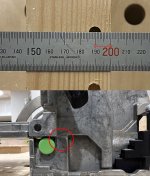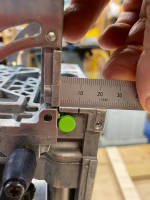Hi guys,
I got a Domino 700 and it seems to me the height setting is not working well. Not using the height presets at all, with the machine set at the minimum height, the minimum height I get is above 10mm, almost 1mm off, the center of the hole is at almost 11mm the top of the workpiece. I made sure there's no dust trapped preventing the machine to go as low as possible and as hopefully you can see in the picture there's no gap at all. Does anybody have a clue what's going on or if I am doing something wrong?
Thanks in advance.
I got a Domino 700 and it seems to me the height setting is not working well. Not using the height presets at all, with the machine set at the minimum height, the minimum height I get is above 10mm, almost 1mm off, the center of the hole is at almost 11mm the top of the workpiece. I made sure there's no dust trapped preventing the machine to go as low as possible and as hopefully you can see in the picture there's no gap at all. Does anybody have a clue what's going on or if I am doing something wrong?
Thanks in advance.


